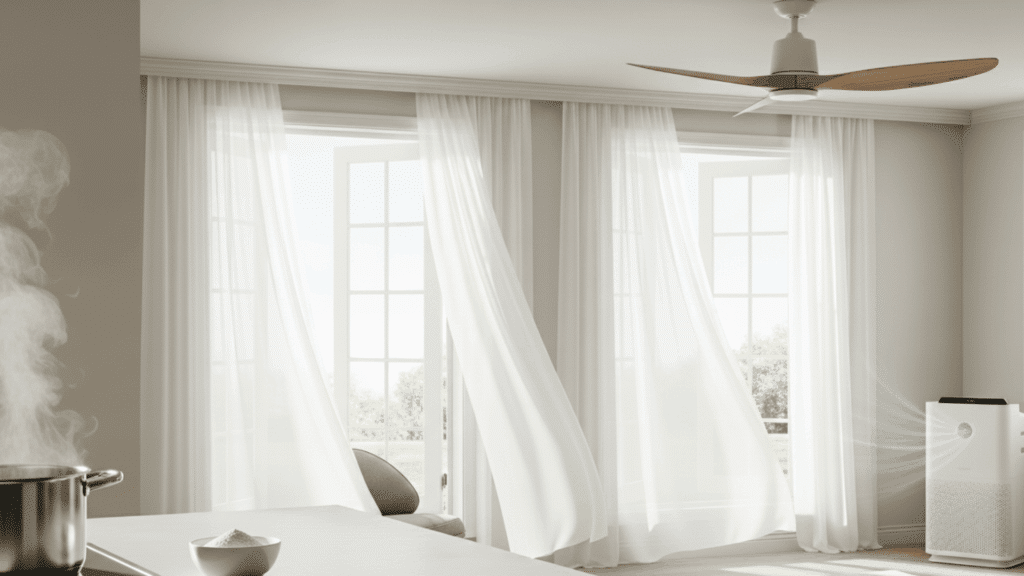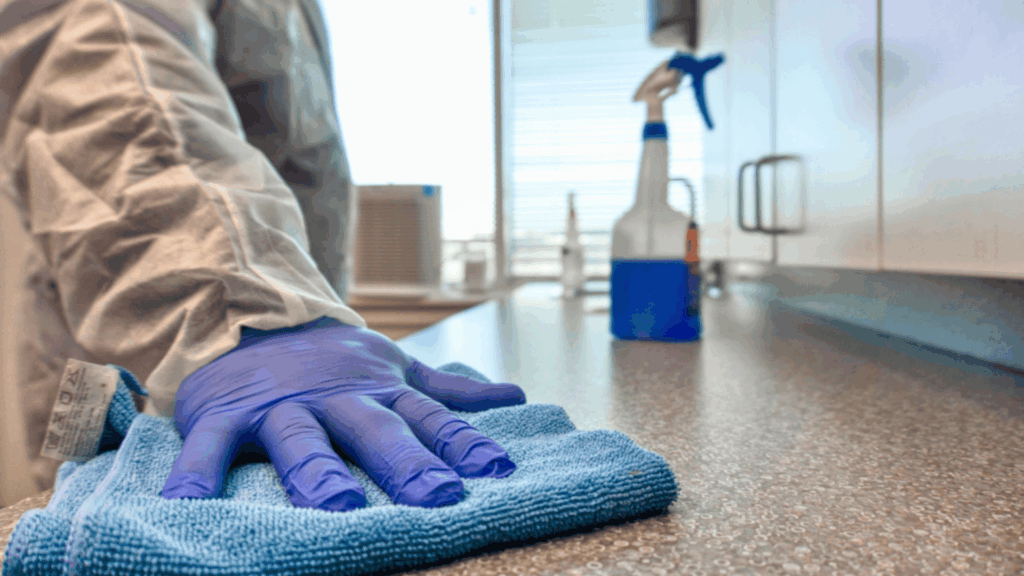I know how frustrating it feels when the smoke smell lingers in your home. It doesn’t matter if it comes from cooking gone wrong, cigarettes, or even a small fire; it hangs in the air and settles into everything.
Your walls, furniture, and vents soak up those tiny particles, and no candle or spray can truly cover them. The good news is that there are clear steps you can take that actually work.
Here, I’ll walk you through practical methods for how to get the smoke smell out of your house. You’ll find simple fixes for quick relief, deeper cleaning tips for stubborn odors, and advice on when professional help makes sense.
Why Smoke Odors Linger?
Smoke particles are super-fine, sticky, and stubborn. They slip into porous surfaces, like fabrics, drywall, and ductwork, and cling to walls, furniture, and vents. Temporary sprays or candles only mask the problem because they don’t remove what’s embedded.
Different types of smoke also behave differently:
- Kitchen Smoke (burnt food): Usually sharp and acrid, but easier to tackle if addressed quickly.
- Cigarette Smoke: Leaves a sticky nicotine film that builds up over time.
- Fire Smoke: Contains soot and heavy residue that clings to walls, ceilings, and HVAC systems.
Understanding this helps you pick the right strategy.
How to Get Smoke Smell Out of the House?

The first step is removing fresh smoke as soon as possible. Acting quickly prevents the odor from sinking deeper into walls, fabrics, and vents.
1. Ventilate
Open every window and door you can. Place a box fan in a window facing outward so it pushes smoky air outside rather than moving it around indoors.
If you have ceiling fans, switch them on to keep the air flowing. Fresh air circulation makes a big difference in the first hour.
2. Remove the Source
Find what’s causing the smell and get it out fast. Burnt pans, food scraps, ashtrays, or cigarette butts keep releasing odor until they’re gone.
Seal them in a trash bag and move them outdoors right away. The sooner the source is gone, the easier it is to clean the air.
3. Run Air Purifiers
An air purifier with a HEPA filter removes tiny smoke particles from the air, while a carbon filter absorbs odor molecules.
Place the purifier in the room most affected and let it run for several hours. If your unit has multiple speeds, keep it on the highest safe setting until the air feels fresher.
4. Address Burnt Smells Quickly
For cooking accidents or small kitchen fires, use targeted fixes. Switch on the stove vent or range hood to pull smoke out.
Boil a pot of water with a cup of vinegar for 15 minutes to neutralize odors. You can also leave bowls of baking soda near the stove to soak up the burnt smell overnight.
Absorbing and Neutralizing Odors: Quick Fixes
Sometimes the simplest methods work best. Here are common options and how they help:
| Method | How It Works | Best Used For |
|---|---|---|
| White Vinegar | Neutralizes odor molecules when left in bowls or used in cleaning solutions | Rooms with general smoke odor and surface wipe-downs |
| Baking Soda | Absorbs smells trapped in fabrics and fibers | Carpets, rugs, and upholstered furniture |
| Activated Charcoal | Pulls odors from the air over time | Bedrooms, closets, or small enclosed spaces |
| Vanilla Extract | Adds a light scent while absorbing odor | Problem spots that need a gentle fragrance boost |
| Store-Bought Options | Ready-made odor absorbers like sprays, gels, or charcoal bags | Quick solutions or long-term placement around the home |
These quick fixes work well on their own but are even more effective when combined with deeper cleaning.
Deep Cleaning for Persistent Smoke Smell
If the odor has already settled into your home, follow these steps to tackle it thoroughly:
- Clean Fabrics: Start with bedding, curtains, and clothing. Use odor-removing detergent and run it through a full wash cycle. For delicate fabrics, take them to a dry cleaner and explain that they were exposed to smoke.
- Refresh Carpets and Upholstery: Vacuum with a HEPA-equipped machine to capture fine particles. For heavy smells, steam clean carpets, rugs, and sofas. In lighter cases, sprinkling baking soda overnight and vacuuming the next day can be enough.
- Wash Walls and Ceilings: Mix warm water, vinegar, and a mild soap. Wipe walls and ceilings in sections, then rinse with clean water. This removes the thin smoke film that often traps odors.
- Wipe Hard Surfaces: Clean cabinets, shelves, doors, and windows. Pay attention to hidden areas like trim edges and inside drawers, since smoke often collects there.
- Service the HVAC System: Replace filters immediately. Remove and wash vent grilles, then vacuum ducts as far as your hose will reach. If odors still return when the system runs, professional duct cleaning may be necessary.
Special Cases: Fire Smoke vs. Cigarette Smoke
Not all smoke odors behave the same way. The cleaning methods you use will depend on the source. Fire smoke leaves behind soot and heavy residue, while cigarette smoke causes sticky buildup over time.
| Aspect | Fire Smoke | Cigarette Smoke |
|---|---|---|
| Character | Strong, acrid odor that spreads quickly | Sticky residue with stale smell |
| Main Issue | Soot particles cling to walls, ceilings, fabrics, and ducts | Nicotine film builds up on walls, ceilings, and windows |
| Cleaning Steps | Step 1: Dry wipe soot before wet cleaning Step 2: Wash surfaces with a vinegar-based mix Step 3: Consider ozone or pro help for severe cases | Step 1: Wash walls and ceilings regularly Step 2: Clean windows and mirrors with vinegar Step 3: Vacuum fabrics and carpets often Step 4: Run carbon filter purifiers for ongoing use |
Understanding the difference helps you pick the right approach. While both types need consistent cleaning, fire smoke often requires heavier treatments, and cigarette smoke demands ongoing upkeep.
Professional Cleaning Options

DIY works in lighter cases, but when smoke has spread through multiple rooms or keeps coming back, calling in experts may be the best option.
- Ozone generators that break down odor molecules at their source.
- Industrial HEPA vacuums and extraction tools to remove fine particles.
- Specialized cleaning solutions designed to treat soot and nicotine buildup.
While this service can be costly, it saves time and ensures the odor is removed safely and thoroughly.
Preventing Smoke Smells in the Future
Once your home is fresh again, a few habits help keep it that way:
- Avoid smoking indoors to prevent sticky residue.
- Ventilate daily to keep fresh air circulating.
- Use HEPA air purifiers in main living areas for ongoing odor control.
- Change HVAC filters every 2–3 months.
- Air-seal homes in smoke-prone areas (wildfire zones, multi-unit buildings).
- Keep odor absorbers like baking soda or charcoal bags in closets and small rooms.
By keeping up with these simple steps, you’ll stop odors from building up and make your home easier to maintain long term.
Final Thoughts
Getting smoke odor out of a home isn’t instant, but it can be done with steady effort. You’ve seen how quick fixes, deep cleaning, and even professional help all play a role.
Now you know practical ways for how to get smoke smell out of a house, starting with simple steps and moving into stronger solutions when needed. Each choice you make brings you closer to a cleaner, fresher space.
I hope these tips give you the confidence to take action and improve your home. If you’d like more ideas to keep your spaces comfortable and healthy, check out other posts for guidance you can use anytime.














